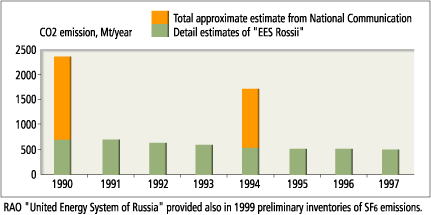I. Title of the Best Practice
Inventories of Greenhouse Gas Emissions
II. Overview of the Best Practice
The existing inventory data in the Russian Federation might be improved towards to high quality greenhouse gas (GHG) emission inventories, required by the UNFCCC and the Kyoto Protocol by several ways and among them:
- Adaptation for Russian circumstances of the IPCC 1996 Revised Guidelines on National Inventories and of further issues of the IPCC and additional simplifying assumptions.
- Improvements of national inventory system.
- Improvements of sectoral and regional inventory systems.
In spite of limitation of resources a number of efforts have been done in this direction. The Institute for Global Climate and Ecology (of the Russian Academy of Sciences and Russian Federal Service for Hydrometeorology and Environmental Monitorung) is planning to reallocate partly the resources under the Federal program "Prevention of Dangerous Climate Changes and Its Negative Consequences" and to direct more resources to the subprogram on emissions inventory to get at least approximate estimates of GHG emissions in the country as a whole and provide UNFCCC Secretariat with the summary data.
In energy sector, the Ministry of the Russian Federation of Fuel and Energy, and in particular, the Institute of Energy Strategy, plans to get credible estimates for country as a whole for last years. A number of Russian companies in energy sector ("United Energy System of Russia", "LUKoil" and others) plan to make their parts of inventory themselves.
There arise the following questions about:
- the possibility of creating a system satisfying the international standards for a minimal amount of money
- the well-justified calculation of the really needed expenses for more precise calculation of emissions.
We can answer questions only going "bottom - up". There are two current directions of activities in this field.
1) To undertake inventory in one of the administrative regions of Russia, get the required experience and then copy this process in the other regions of Russia. The situation here is eased by the fact that there exist regional authorities that control atmospheric emissions and accumulate a large part of information needed for calculation of GHG emissions. They have also a qualified personnel and very well established mechanism of supplying the Federal authorities with the emission data. That is this fact which allows to hope for reducing substantially the total costs of creation the GHG emission estimation system.
In 1999 there was successfully implemented a Pilot Project on Inverntories in Novgorod Region (with support of the US EPA and PNNL). Inventory level was also focused on expected requirements of the Kyoto Protocol, i.e. there will be information basis for development of JI projects as well as pilot AAU transactions (we mean level of largest enterprises). Supplementary "Guidelines for GHG Inventory in Russia on Regional Basis" were also prepared under the project. The Guidelines will be supplementary to the Workbook of the IPCC Revised Guidelines and will facilitate use of IPCC methodology in Russian circumstances. The main attention has been paid for receiving and estimation of activity data (e.g. fuel combustion, cement production, agriculture fertilisation, etc.). In year 2000 it is planned to extend such regional works on 2-3 other regions.
2) To establish effective incentives and conditions for voluntary GHG inventory works of the largest companies on their enterprises. We mean, first of all, energy and fuel companies.
There is already an example of good practice - GHG emission inventory of the RAO "United Energy System of Russia" (RAO "EES Rossii" - Russian monopolist in energy production. Transparency of this inventory is as deep as data on different fuel use in each year on each power station. Actually all large and middle stations of the country are covered by this inventory (about 370 Russian power stations). It is completely consistent with IPCC methodology and contains all IPCC Worksheets. One more advantage is development of specific emission factors for Russia. "EES Rossii" has collected and analysed results of researches of the previous years and developed relevant factors. These values are very close to default IPCC values, however difference is not considered as important fact. It is the most important that inventory works were carried out on as high as possible quality level. Actually this work is the first example of good practice. Probably the part of national GHG emission covered by this inventory is part of Russian inventory which are already determined with good accuracy, transparency and low uncertainty ( see Figure 1).
The CO2 estimates conducted by the "EES Rossii" cover only about a quarter of the total GHG emission in Russia. However this work allows to say that in Russia there is already a significant part of inventory on a level which might be required for purposes of the Kyoto Protocol.
Figure 1. Total estimate of CO2 emission from the Second Russian National Communication and CO2 emission covered by detail inventory of "EES Rossii"

|